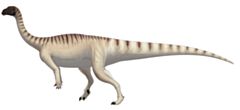Project 4561: A. Otero, D. Pol. 2021. Ontogenetic changes in the postcranial skeleton of Mussaurus patagonicus (Dinosauria, Sauropodomorpha) and their impact on the phylogenetic relationships of early sauropodomorphs. Journal of Systematic Palaeontology. 19 (21):1467-1516.
Abstract
Early sauropodomorphs were diverse in Gondwana, being particularly well represented in South America. Mussaurus patagonicus is one of the best-known non-sauropod sauropodomorphs that inhabited the Southern Hemisphere. Its importance relies on its phylogenetic position close to Sauropoda and also because it is known from a well-represented ontogenetic series, including embryos, neonate and late immature skeletons, which are particularly scarce among sauropodomorphs. In this regard, Mussaurus represents an excellent opportunity to explore anatomical and palaeobiological constraints during the ontogeny of early stages of the evolution of the group. We present the osteology of the postcranial skeleton of immature specimens of Mussaurus, highlighting the main anatomical changes that occurred during its ontogeny. The phylogenetic position of this taxon based on mature specimens is evaluated through a parsimony analysis, corroborating its position as closer to Sauropoda than most other early sauropodomorphs. Immature stages of this taxon were also evaluated phylogenetically, showing an overall phylogenetic signal that positioned them closer to the root of Sauropodomorpha than the mature specimens. However, the cranial and some postcranial anatomical partitions of neonates and late immature specimens have different phylogenetic signals, showing derived traits present in Sauropoda and related taxa (and supporting the hypothesis of paedomorphic evolution in certain regions of the skeleton). Our analysis shows that most of the appendicular apomorphies in Mussaurus appear late in ontogeny, whereas axial characters (in particular for OS 1), including those of the skull and the presacral vertebrae, show derived character states early in ontogeny that are congruent with the phylogenetic position of mature specimens. Ontogenetic series of other sauropodomorph species, however, are required to test if this pattern applies to the entire group.Read the article »
Article DOI: 10.1080/14772019.2022.2039311
Project DOI: 10.7934/P4561, http://dx.doi.org/10.7934/P4561
| This project contains |
|---|
Download Project SDD File |
Currently Viewing:
MorphoBank Project 4561
MorphoBank Project 4561
- Creation Date:
10 February 2023 - Publication Date:
10 February 2023
Authors' Institutions ![]()
- Museo Paleontológico Egidio Feruglio
- Consejo Nacional de Investigaciones Científicas y Técnicas (CONICET)
- Museo de La Plata
Members
| member name | taxa |
specimens |
media |
| MorphoBank Curator Project Administrator | 1 | 1 | 1 |

